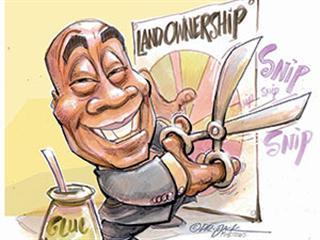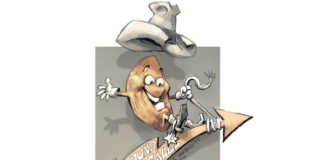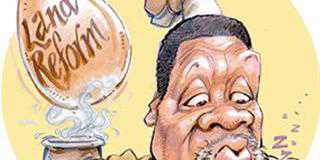
This year marks the centenary of the Natives Land Act of 1913, an historic occasion that was highlighted at a number of events over the past few months. The first was in December last year, when the governing party held its 53rd National Elective Conference in Mangaung in the Free State. As is evident in the conference resolutions, rural development and land reform remain one of the apex priorities of the governing party.
However, government is aware that organised agriculture still has concerns about some of the policy proposals on the table. We are therefore very happy that organised agriculture participated fully throughout the consultation process and truly believe that the product we are now about to submit to Cabinet is much better than what we had originally, thanks to all the participants’ dedication.
We are still committed to our target of redistributing 30% of the country’s land. The Green Paper on Rural Development sets the broad parameters of how the country seeks to go about rural development and agrarian reform. We need to work together to find ways and strategies of effecting land reform that address issues of restorative justice while ensuring food and economic security. Organised agriculture is a vital partner.
The second notable event was the State President’s fourth State of the Nation Address, where he announced that the National Development Plan (NDP) was the blueprint that government would pursue to combat poverty, unemployment and inequality towards 2030. The third event was the budget speech by the Minister of Finance on 27 February, where he underscored the centrality of the NDP by effectively tying the budget allocation for the 2013/2014 financial year to the plan.
There are several key issues common to these three events, and together they show why it is more important than ever for government and the private sector to work together.
A realistic look at land reform
The first is the renewed focus on rural development and land reform, a subject deliberated at length by the Commission on Economic Transformation at Mangaung. The conference thereafter announced several legislative reforms intended to speed up land reform and establish institutions to ensure the programme is sustainable. The establishment of the Office of the Land Valuer-General, for example, must ensure that the state pays fair and equitable compensation for land it acquires from landowners. Recent experience has shown that the state pays twice as much for land restitution as for land redistribution.
This is financially unsustainable and will make the restitution process last much longer than it should, as the state gets less and less value for every rand it pays. Related to this point, however, is the realisation that in order to have a fighting chance of success, new farmers need financial support from the state. Various financing models are thus being investigated. The experience of organised agriculture in developing support institutions, supporting developing farmers, designing financing models and building competitive businesses, cannot be over-emphasised.
Tackling hunger and poverty
The second key issue is that there are nearly 12 million South Africans who are food insecure, while socio-economic inequality levels are unacceptably high, as evidenced by our national Gini co-efficient, which is one of the highest in the world at 0,7. Over 72% of those who are food insecure live in rural areas – predominantly the former Bantustans. Moreover, the poorest 20% of the population contribute only 3,3% of the country’s GDP, while 10% of the population contribute almost half.
The NDP has identified sustainable land reform and rural development as a crucial lever to turn this situation around. Agriculture has the potential to create 1 million jobs by 2030 and directly contribute to helping at least 400 000 people a year escape rural poverty. The DRDLR is working closely with the National Planning Commission and the economic and employment cluster departments to ensure that the programmes of the relevant departments, including the New Growth Path (NGP), are aligned to the NDP. In this process, we plan to engage the private sector to develop partnerships and strengthen existing ones.
Loss of crop lands to mining
A third but related key issue is the need for government and the private sector to find a balance between two seemingly competing job drivers: mining and agriculture. The NGP identifies these two sectors as key to achieving economic growth and creating much-needed jobs. Coal plays a critical role in meeting the country’s energy requirements, and many of the deposits are found on prime grain-producing land, particularly in Mpumalanga. In fact, more than 46% of the country’s high agricultural potential soil is found in this province.
The need to find a balance between mining and agriculture is therefore critical. According to a July 2012 survey by the Bureau for Food and Agricultural Policy at the University of Pretoria, entitled Structural Shifts & Food Security Focus, projections show that the country is likely to lose a million tons of grain production to mining activities within the next two years or so.
At the current rate of coal mining in Mpumalanga, it has been projected that approximately 12% of South Africa’s total high potential arable land will be transformed, while a further 13,6% is being prospected in the province. This amounts to 993 301ha of farm land.
Alternative arable land
Additional crop land needs to be found urgently elsewhere in the country to offset this shortfall. The Department of Agriculture, Forestry and Fisheries (DAFF) has identified nearly 800 000ha of arable communal land in the Eastern Cape and nearly 600 000ha more in Limpopo, KwaZulu-Natal, Mpumalanga, North West and the Free State. This excludes nearly 7 million hectares of land acquired under the government’s land reform programme.
Government introduced the Integrated Food and Nutrition Security Programme in order to help smallholder farmers on communal land to grow crops. The DRDLR, which is helping to co-ordinate this effort, initiated discussions with Grain SA to forge a national public-private partnership to drive this initiative. Working with rural communities, black small-scale farmers and organised agriculture, we will develop a national food production plan where government will guarantee off-take by acquiring food produced by smallholders. Data shows that the state spends close to R6 billion procuring food and food-related items annually through its various institutions.
In the end, we want a national food production plan that will fully integrate smallholder farmers and related agro-industries into the mainstream of the sector. This initiative will be a catalyst for other commodities such as red meat, poultry, sugarcane and timber. The plan is at the heart of what we refer to in the Comprehensive Rural Development Programme as agrarian transformation.
Developing infrastructure
Another key strategic area is the infrastructure programme led by the president through the Presidential Infrastructure Co-ordinating Commission. There are 18 integrated strategic infrastructure projects (SIPs), each presenting various opportunities for the agricultural sector. Several key SIPs will affect the sector directly. Examples are SIP 2, the development of the Durban-Free State-Gauteng logistics corridor, and SIP 3, the south-eastern node and corridor development that will promote rural development through a new dam in Mzimvubu, irrigation schemes and the N2 gateway.
The latter will, among other things, improve access into KwaZulu-Natal and national supply chains. Another project critical to the sector is SIP 11, which deals with agro-logistics and rural infrastructure. This aims for investment in agriculture and rural infrastructure to support expansion of production and employment. The fruit and vegetable hubs of Limpopo and the Western Cape provide a fulcrum for this SIP. Investment will involve areas such as transport linkages, cold chains, irrigation schemes and export incentives.
Land reforms at municipal level
The final area of focus is the proposal in the NDP for the establishment of district land reform committees to drive and co-ordinate land reform in an inclusive manner. We are happy to announce that work is under way to develop a framework, including inter-governmental and spatial land-use elements, which the department will use to consult stakeholders on how to produce ‘mini’ versions of the national 2030 spatial and development plans in each of the 47 rural district municipalities.
The process to develop these plans and the structures to implement them will be as inclusive, transparent and consultative as possible. – Annelie Coleman
This is an edited version of a speech by Director-General of Rural Development and Land Reform Mduduzi Shabane at the 2013 Grain SA Congress. For more information, contact DRDLR spokesperson Tshepo Diale on 012 312 8532. The views expressed in our weekly opinion piece do not necessarily reflect those of Farmer’s Weekly.













